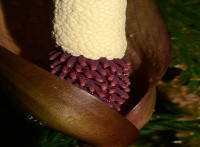Effect of Anchomanes difformis Ethanol Root Extract on Electrolyte Level of Testosterone-Induced Benign Prostatic Hyperplasia in Wistar Rats . http://www.doi.org/10.26538/tjnpr/v6i12.22
Main Article Content
Abstract
Benign prostatic hyperplasia is the most common male benign proliferative disease; characterized by overgrowth of prostatic tissue around the urethra constricting the urethral opening. The study investigated the effect of Anchomanes difformis ethanol root extract on electrolyte level of testosterone induced benign prostatic hyperplasis in Wistar rats. Forty-two matured male Wistar rats weighing 150-180 g were divided into 6 groups of 7 animals each and acclimatized for 7 days. Prostate was induced with 5mg/kg of testosterone for 21 days. Two animals were sacrificed and blood collected for PSA assay. Groups 4, 5 and 6 were treated with 1000 mg/kg, 500mg/kg and 250 mg/kg of the extract respectively. The testosterone induced group 3 was treated with finesteride standard control and group 2 represented the BPH induced control group, while group 1 served as normal control. The administration of the extract lasted for 21 days. The results obtained showed a nonsignificant (P>0.05) increase in Na+ (mmol/L) concentration at 1000mg/kg of plant extract Bph C group vs normal control, while the finesteride group had no effect on Na+ concentration treated with Bph C group. There was a
significant (p<0.05) reduction in Cl- concentration at 1000mg/kg vs 5mg/kg of testosterone and 5mg/kg and finesteride, with no significant (p>0.05) effect at 500 mg/kg Vs normal control. For K+ (mmol/L) concentration in plant treated groups, 1000 mg/kg increase significantly at 250 mg/kg. Conclusively, the results suggested, Anchomanes difformis root extract has the potential to maintain serum electrolytes in benign prostatic hyperplasia management induced by testosterone and diarrhea patients.
Downloads
Article Details

This work is licensed under a Creative Commons Attribution-NonCommercial-NoDerivatives 4.0 International License.
References
Christian A, Yaw DB, John AA, Susana OD, Theresa A, Adobea A. Antimicrobial and Anti-Inflammatory properties of Anchomanes difformis (BI) Engl. and Colocasia esculenta (L) Schott Biochem and Pharmacol (Los Angel). 2016; 5:201.
Alabi TD, Nicole B, Oguntibeju O. Medicinal activities of Anchomanes difformis and its potential in treatment of Diabetes mellitus and other Disease conditions. J. Phytomed. 2018;219-233.
Bellow OM,JagabaSM, Bellow OF. A wild edible vegetable Anchomanes difformis (Blume). It's ethanomedicinal, phytochemistry, nutritional importance and other uses. Asian J. Biosci. 2019; 13:1137-1147.
Nonde-Ntandou GF, Kimpouni V, Loufoua BE, Yengozo BP, Etou-Ossibi AW, Hou RG, Ouamba JM,Abena AA. Laxative and diuretic effects of Anchomanes difformis (Araceae). J Pharmacognosy and Phytochemistry, 2017;6(3):234-242.
Ahmed HA. Anchomanes difformis: A multipurpose phytomedicine. J Pharm Bio Sci.2018;13(2):62-65.
Apinega LA, Dianma S, Ladan Z, Inusa BK, Adejoke SA, dauada G, Musa AM. Isolation and characterization of Lup-20 [29] –en- 3β-ol from the methanol stem Bark Extract of Bombax costatum PV [Bombaceae]. TropJ Nat Prod Res. 2018; 2(6):290- 292.
Noba K. Bassene C. Ngom A. Gueye M, Camara AA. Invasive plants of West Africa: Concepts, Overviews and sustainable Management, Advances in Recycling Waste Management. 2017; 2:121.
Young B, O’Dawd G, Woodford P. Wheater’s Functional histology: A test and colour atlas (6thed). Philadelphia: Elsevier. 2013; 237-8.
Kayalvizhi I, Bhoria S, Khanagwal VP, Narayan RK. Morphology Study of Prostate in different ages of Indian. JMorphol Sci. 2017;34(1):40-43.
Atamgba AA, Richard UU, John EO. The effect of acute Coadministration of fansidar with vitamin C on som serum electrolytes and body weight changes in male and female Wistar Albino rats. British J Med Res. 2016; 12(8):1-3.
Lebdai S, Chevrot A, Doizi S, Pradere B, Delongchamps NB, Benchikh A. Do patients have to choose between ejaculation and miction? A systematic review about ejaculation preservation techniques for benign prostatic obstruction surgical treatment" (PDF). World J Urol. 2019; 37(2):299–308.
Ovuakporie-Uvo O and Macdonald I. Phytochemistry, antiasthmatic and antioxidant activities of Anchomanes difformis (blume) Engl. leaf extract. Asian J Trop Biomed. 2016; 6(3):225- 231.
Afieroho OE, Ndukauba EC, Ibok FS. Activity Guided Fraction of Anchomanes difformis (Blume) Engl. (ARACEAE) Stem Ethanol Extract: in search of free radical scavenging agents. The Saudi J Life Sci. 2020;5(4):38-45.
Vignera SL, Condorelli RA, Russo GI, Morgia G, Calogero AE. Endocrine control of Prostatic hyperplasia. J Andrology, 2016; 4(3):404- 411.
Sonja C,Marlon P, Shannon McGrath, Nathan L. Prostate cancer screening with prostatic antigen: A guide to the guidelines. Prostate Inter. 2016; 4(4):125-129.
Lerner LB, McVary KT, Barry MJ. Management of lower urinary tract symptoms attributed to benign prostatic hyperplasia: AUA Guideline part 1, initial work –up and medical management. J Urol. 2021; 206:806-818.
Golla VK and Kaplan AL. Testosterone therapy on active surveillance and following definitive treatment for prostate cancer. J Urol. 2017; 6(9):5-6.
Vignozzi L, Rastrelli G, Corona G, Forti G, Maggi M. Benign Prostatic hyperplasia: A new metabolic disease? J Endocrinol invest. 2016; 37:313-322.
Vijayasamundeewari CK, Ananthi N, Sudha R. Comparison of electrolyte level in serum and plasma. Inter J Clin Biochem Res. 2017; 4(2):113-118.


